LONDON SURVIVES END-OF-YEAR BLITZ
London, England • December 29, 1940
On this date in 1940, when President Franklin D. Roosevelt appealed to the nation in a radio “fireside chat” to support his proposal to strengthen the U.S. military in light of developments in Europe, the German Luftwaffe delivered a massive attack on London. Almost 3,000 civilians were killed in the overnight bombing.
The December 29th airstrike on the British capital completely torched London’s City District, or “Square Mile,” where much of the nation’s financial trading and business transactions were carried out. The late-December airstrike by 136 bombers, described as the second “Great Fire of London” by a U.S. reporter cabling an account back to his office (the original Great Fire dated to 1666), was part of the Luftwaffe’s sustained strategic bombing campaign of Great Britain and Northern Ireland, which the British public dubbed the Blitz (September 7, 1940, to May 10, 1941). The Blitz (shorthand for the German Blitzkrieg, “lightning war”) was Adolf Hitler’s punishment for Britain’s refusal to surrender their island to him during the Battle of Britain. For 57 nights straight (September 7 to November 2, 1941), 200 or more German bombers dropped high-explosive and incendiary bombs on London.
Across the nation many civilian and industrial targets faced similar onslaughts—Liverpool, Cardiff, Bristol, Manchester, Belfast, Coventry, and Glasgow to name a few. More than a million London residences were destroyed or damaged and more than 40,000 civilians killed, almost half of them in London alone. (British urban dead would number over 60,000 when the war ended in May 1945.) During 8 bleak months of being pounded from the air Great Britain stood alone and defiant. Not until December 11, 1941, would the United States enter the war on the side of Britain, and that was nearly a year away.
The Blitz never achieved its intended goals of either demoralizing British political and military leaders into capitulation or significantly damaging the country’s economy to continue the war. Roosevelt’s December 29 appeal, memorable for its line that the U.S. must become the “arsenal of democracy” for the nations standing up to Nazi Germany, Fascist Italy, and Imperial Japan, was realized in the Lend-Lease Program, which kicked off in March 1941. The first delivery of supplies reached to the beleaguered British Isles in mid-year. (Food was the largest single category in 1941.) By the time the last of the Luftwaffe’s bombs had fallen on London on May 10, 1941, in a particularly savage climax to the Blitz (507 aircraft dropped 711 tons of bombs, killing or wounding more than 3,000 people), the threatened cross-channel amphibious invasion of England (Operation Sea Lion) had passed. Hitler’s attention now shifted to the east, to the Soviet Union. His strategic gamble to annihilate his opponent in the east in one massive battle, Operation Barbarossa, which appeared so promising when initially launched, had the most grievous consequences when his yearlong winning streak broke.
The Blitz, Germany’s Strategic Bombing of Great Britain, September 7, 1940, to May 10, 1941
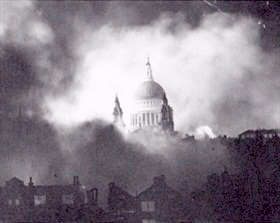 | 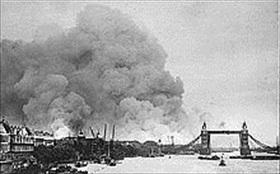 |
Left: London’s St. Paul’s Cathedral, mostly unscathed, ringed by clouds of smoke in this iconic photograph taken on December 29, 1940, from the roof of the Daily Mail building by the paper’s chief photographer, Herbert Mason. Almost every building north and northeast of St. Paul’s was destroyed (the city recorded 1,500 fires), leaving row upon row of free-standing walls and fire-blackened ruins creaking in the wind. The cathedral was struck 4 times during the Blitz: in September, October, and December 1940 and in April 1941. In the December raid, the cathedral was hit by 28 incendiaries, causing the gigantic dome’s outer lead covering to melt. One enemy incendiary bomb succeeded in punching halfway through the dome’s lead covering, the brilliant white light of the sputtering bomb giving the impression that that the cathedral had been set ablaze. Miraculously, the bomb fell outward, slid down the outside of the dome, and landed in the walkway that circles the bottom of the dome. There it was easily disposed of by volunteer members of St. Paul’s Watch. The “divine intervention” was referred to as the “Miracle of St. Paul’s.”
![]()
Right: Surrey docks in flames east of Tower Bridge on the Thames in Southeast London on the start date of the Blitz, September 7, 1940. During the course of the Blitz, over 100,000 tons of shipping was damaged in the Thames Estuary, 800 civilians were injured, and 400 civilians were killed. Between January and May 1944 the Luftwaffe assaulted Southern England in an operation codenamed Operation Steinbock (Unternehmen Steinbock), known colloquially as the “Baby Blitz.” The operation achieved very little other than wearing down the offensive power of the Luftwaffe. Steinbock turned out to be the last strategic air offensive by the German bomber arm during World War II.
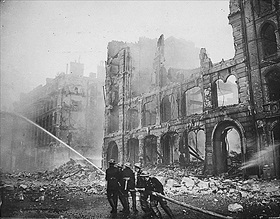 | 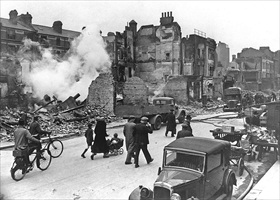 |
Left: Firefighters of the London Fire Brigade bravely battle a conflagration on Queen Victoria Street with water hoses during the devastating overnight air raid on the capital city on May 10/11, 1941. Less than halfway into the 37 weeks of the Blitz, Luftwaffe hordes had dropped more than 13,000 tons of high explosives and nearly 1,000,000 incendiaries on London. The number of bombers varied from night to night; for example: October 6, 7 bombers; October 15, 380. Using a scatter-gun approach, they dropped their deadly payload everywhere: on Westminster Abbey, St. Paul’s Cathedral whose dome dominated the skyline, Buckingham Palace (9 times during the war), No. 10 Downing Street (the official home of the British prime minister), the Tower of London, the British Museum, on hospitals, theaters, churches, the London Zoo, on rich and poor neighborhoods, and on arguably military and war-industrial installations. After Buckingham Palace had suffered a hit on September 13, 1940, Queen Elizabeth, wife of King George VI, remarked that damage to the royal residence meant she could better empathize with ordinary citizens.
![]()
Right: A street of ruined houses in London. More than a million London houses were destroyed or damaged and close to 20,000 Londoners killed during the 267 days of the Blitz. The city was scarred but not devastated because its great sprawl meant that the violence lacked concentration. By contrast the Allied bombing raid on the large North German port and industrial center of Hamburg (population 1.8 million) during the last week of July and the first week of August 1943 (Operation Gomorrah) killed 42,600 civilians, of which 7,000 were children or adolescents, wounded 37,000, and practically leveled the city in a series of one-two punches, first by high explosives and then by incendiaries: 9,000 tons of bombs in all. Local rescue efforts stalled after British bombers cut electricity to a major portion of the city for 2 weeks. One million Hamburgers fled the city, where in just 8 days over 250,000 residences were destroyed. In the case of Hamburg, London, and every other European city that was at war and became the target of enemy bombings, the number of non-civilians (that is, combatants) killed was low.
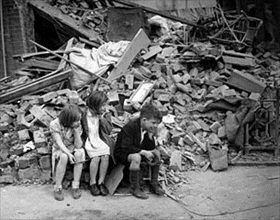 | 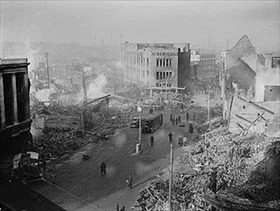 |
Left: Children of an eastern suburb of London made homeless by the Blitz. Though militarily ineffective, the Blitz caused enormous damage to Britain’s infrastructure and housing stock. An estimated 1 in 6 Londoners suffered homelessness during the bombing campaign.
![]()
Right: Coventry city center after 449 German bombers had dropped 530 tons of bombs on the night of November 14/15, 1940. With poor antiaircraft defenses for a city of nearly 240,000 people with many wartime industries, Coventry was smashed: 75 percent of all buildings, 33 percent of all factories, and 50 percent of all homes (4,300) were destroyed by a combination of German high-explosive bombs and incendiaries. To show for it, the Germans lost 1 bomber to antiaircraft fire.
Amateur Color Film of Destruction Caused by London Blitz, 1941 (Suggest silencing the projector’s sound)
![]()

 History buffs, there is good news! The Daily Chronicles of World War II is now available as an ebook for $4.99 on Amazon.com. Containing a year’s worth of dated entries from this website, the ebook brings the story of this tumultuous era to life in a compelling, authoritative, and succinct manner. Featuring inventive navigation aids, the ebook enables readers to instantly move forward or backward by month and date to different dated entries. Simple and elegant! Click
History buffs, there is good news! The Daily Chronicles of World War II is now available as an ebook for $4.99 on Amazon.com. Containing a year’s worth of dated entries from this website, the ebook brings the story of this tumultuous era to life in a compelling, authoritative, and succinct manner. Featuring inventive navigation aids, the ebook enables readers to instantly move forward or backward by month and date to different dated entries. Simple and elegant! Click 











